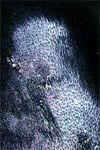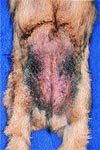Topical therapies can offer relief for some skin conditions
In my practice, I receive numerous phone calls for consultations concerning the choice of shampoo or specific topical spray/lotion to treat skin disease. It can be very difficult to choose the right topical product. But with a few tips, a few rules to follow and some insight into shampoo ingredients, you'll be well on your way.
In my practice, I receive numerous phone calls for consultations concerning the choice of shampoo or specific topical spray/lotion to treat skin disease. It can be very difficult to choose the right topical product. But with a few tips, a few rules to follow and some insight into shampoo ingredients, you'll be well on your way.

Photo 1: A 2-year-old Coonhound with severe pruritus, odor, and hair loss with hyperpigmentation and lichenification on face and neck.
Variety of skin types
Normal skin: Normal skin should be relatively smooth and range in color from pink to black. Some dogs develop blackening (hyperpigmentation) of the skin and could be a normal finding over time. The skin secretes oil and sweat but should not be greasy or oily. A few exfoliated cells can be found (sometimes confused as pathology called seborrhea) but should be difficult to find and not adhered to the skin or hair shafts.
Normal skin should not be thickened (lichenification) unless it is in an area of trauma or pressure. Normal pressure point calluses occur in areas of trauma over boney prominences such as the elbows, lateral tarsi, and points of the hips. Some breeds such as bull terriers can develop large pressure points over odd places such as the dorsal bridge of the nose.
Some areas can have increase moisture or exudation (oil) under normal conditions and can include skin fold areas, lip folds, vulvar folds and ear canals. These areas trap moisture, and unless pruritus, alopecia, erythema, or odor and discharge are evident may be a normal finding.

Photo 2: An 8-year-old Newfoundland with epidermal collarettes and alopecia on trunk.
Abnormal skin: Skin that is diseased, infected, or traumatized can display evidence that something is not "normal". Increased amounts of exudation can occur (mainly oil from sebaceous gland origin) and produce an oily or waxy feeling. This can act as a "culture medium" and microbial colonization with either staphylococcus or Malassezia (yeast) can occur. Bacterial or yeast overgrowth can also result from other causes including increased moisture from licking/self-trauma or simply from uncontrolled allergy. Increased exfoliation (seborrhea) can be very obvious and be the result of a primary defect in cornification (epidermal skin cell turn-over) or secondary to allergy.
These extra skin cells can harbor microbes readily. Staphylococcus and Malassezia like to "cling" to these surface skin cells and cause disease. Serum oozing from the skin from self-trauma or severe inflammation can cause crusts. Crusts can be pruritic and futher perpeturate the itch/scratch cycle. Crusts can also be formed from dried pus from bacterial infection.

Photo 3: A 4-year-old West Highland White Terrier with very pruritic limbs and feet and numerous papules, pustules, and crusts on groin and rear limbs.
Rules of topical therapy
1. Choice of topical therapy hopefully is based on specific diagnosis.2.Use the least number of preparations.3. Familiarize yourself with the ingredients. 4. Use the mildest form.5. Keep client educated and informed.
Goals of topical therapy:
1. Remove or control abnormal debris on skin. 2. Cure infectious or parasitic disease. 3. Control allergic symptoms.4. Ultimately provide maintenance therapy if needed.
Topical medication formulations
In most topical medications, the product contains the active ingredient(s) and some form of a vehicle. Active ingredients are our main focus when selecting a topical product for a specific dermatologic condition. However, some vehicles can also be beneficial for the treatment and even act synergistically with the active ingredient. The choice of the active ingredient(s) is based upon the disease(s) present and the desired effect.

Photo 4: A 6-month-old Norfolk Terrrier with numerous scales on entire body. Scales are most evident on groin.
Choosing the vehicle is not easily done due to the limited products available to us and the limited types of vehicles used in the topical preparation. Vehicles include alcohols and propylene glycol for example. Also, the vehicle (usually inert in this instance) may facilitate absorption of the active ingredients.
Rules for vehicle choice:
1. Acute lesions: Allow exudation to "flow", encourage drainage, and dry the area being treated. ("If its wet, dry it.")2. Chronic lesions: Rehydrate skin. ("If its dry, wet it")
Active Ingredients
1. Corticosteroids: Supress inflammation (mainly used in the absence of infection). It is used to control pruritus and inflammation. Problems that arise with usage can include thinning of skin with chronic use of higher potency corticosteroids and supressing the adrenal-cortical axis.
2. Antibiotics: Kill bacteria. Antibiotics are very useful in cases of pyoderma. Problems can include contact dermatitis (neomycin). Antibacterials include neomycin/gentomycin, mupirocin, sulfur, benzoyl peroxide, ethyl lactate, chlorhexidine, and acetic acid.
3. Antifungals: Kill fungal organisms. Some can produce contact allergic reactions and have carcinogenic properties. These include sulfur, miconazole, ketaconazole, acetic acid, and chlorhexidine.
4. Antiparasitics: Kill/control external parasites. Widely used (flea control). Problems can include toxicities (mainly with older generation insecticides).
5. Combinations: Some topicals contain a combination of the above.
Specific topicals
1. Emollients: Oils mixed with surface acting agents and aid to soften/soothe the skin. They also prevent excessive water loss.
2. Humectants: Soften keratin on the surface by bonding to stratum corneum. They prevent water loss without oils.
3.Anti-seborrheics: Remove scales and rehydrate skin. They include topicals that have keratolytic and keratoplastic properties.
Keratolytics: They act to soften excessive keratin (dead skin cells) by rehydration. They reduce scales/seborrhea. Examples include sulfur, salicylic acid, tar, propylene glycol and benzoyl peroxide.
Sulfur is antipruritic, antibacterial, parasiticidal and antifungal. Some sulfur preparations have an undesirable and offensive odor.

Photo 5: A 2-year-old Wire-Haired Fox Terrier with pruritus and severe erythema, greasy exudate, some crusts and odor on groin.
Propylene glycol is primarily used as a vehicle/solvent with many topical preparations. It does have some moisturizing/rehydrating properties as well as removing excessive scales.
Tar is a strong antiseborrheic ingredient that is derived from coals and wood. It is toxic to cats. It also can stain various things including jewelry, clothing and lightly colored dogs. Tar can also be carcinogenic.
Benzoyl peroxide is the best antibacterial ingredient with the ability to unplug hair follicle pores (comedones) and its "follicular flushing qualities." It is a good degreaser and is mildly antipruritic. It can excessively dry the skin, so be aware. Keratoplastics: These ingredients "act" on the basal cell layer of the epidermis (the bottom "baby skin cells") and "normalize the cornification process. Examples include tar and sulfur. They can also reduce scales and crusts, kill bacterial and degrease. Few dogs benefit from tar-containing shampoos.

Photo 6: A 10-year-old female cheetah with multifocal patches of alopecia, scale and hyperpigmentation on trunk.
Clinical cases
Case 1: A 2-year-old Coonhound was presented with severe pruritus, odor, and hair loss with hyperpigmentation and lichenification on face and neck (Photo 1, p. 13).
Diagnosis: Cytology revealed numerous Malassezia organisms.
Treatment Plan: Administer 200 mg ketaconazole PO BID and miconazole/chlorhexidine shampoo twice weekly.
Case 2: An 8-year-old Newfoundland was presented with epidermal collarettes and alopecia on the trunk.
Diagnosis: Superficial pyoderma. (Photo 2, p. 14).
Treatment Plan: Cephalexin was administered for three weeks and baths were given twice a week with benzoyl peroxide or ethyl lactate-containing shampoo.
Case 3: A 4-year-old West Highland White Terrier was brought in with very pruritic limbs and feet and numerous papules, pustules, and crusts on groin and rear limbs (Photo 3, p 14).
Diagnosis: Cytology revealed few numbers of Malassezia and numerous cocci. Mild yeast dermatitis and surface pyoderma with underlying allergy.
Treatment Plan: Cephalexin was administered for thee weeks and twice weekly shampoos containing chlorhexidine. Also, recommend corticosteroid-containing spray (triamcinolone) or cream (1 percent hydrocortisone) for pruritus. Allergy work-up is advised.
Case 4: A 6-month-old Norfolk Terrier with numerous scales on entire body. Most scales are evident on groin. (Photo 4).
Diagnosis: Cytology revealed no organisms so a biopsy was performed and revealed ichthyosis (primary cornification defect).
Treatment Plan: Accutane was prescribed and bathing the dog twice a week with a sulfur and salicylic acid-containing shampoo.
Case 5: A 2-year-old Wire-Haired Fox Terrier with pruritus and severe erythema, greasy exudate, some crusts, and odor on groin.
Diagnosis: Cytology revealed numerous cocci. Surface pyoderma and probable underlying allergy.
Treatment Plan: Administer cephalexin for three weeks and dog is bathed twice a week with a tar-based shampoo, and allergy workup is also scheduled. This dog could also benefit from topical 1 percent hydrocortisone twice daily since lesions are predominantly in non-haired areas.
Case 6: A 10-year-old female cheetah with multifocal patches of alopecia, scale and hyperpigmentation on trunk.
Diagnosis: A skin scraping was performed with negative results. Dermatophyte culture revealed Microsporum canis.
Treatment Plan: This dog required sulfur dips preceded by miconazole-containing shampoo twice a week. Griseofulvin was also prescribed.
Choosing the right topical product can be very easy if you become familar with the active ingredients available and the properties and functions they have. Always initiate therapy with the most mild topical product available first. Frequency of application for shampoo can vary with the disease, the owner's compliance, and breed of dog. You can safely bathe most dogs with medicated shampoo once to twice weekly. Several companies market similar shampoos and choosing a variety of shampoos and topicals with different ingredients for your pharmacy will better serve your patients and clients.

Suggested Reading